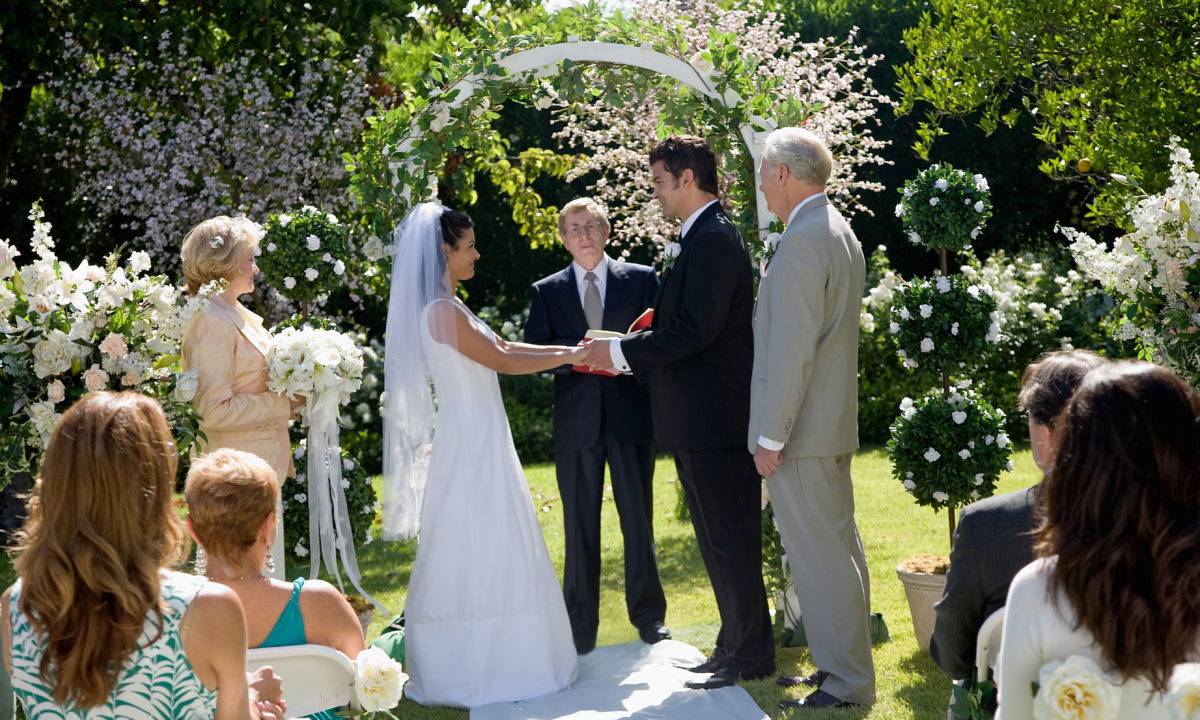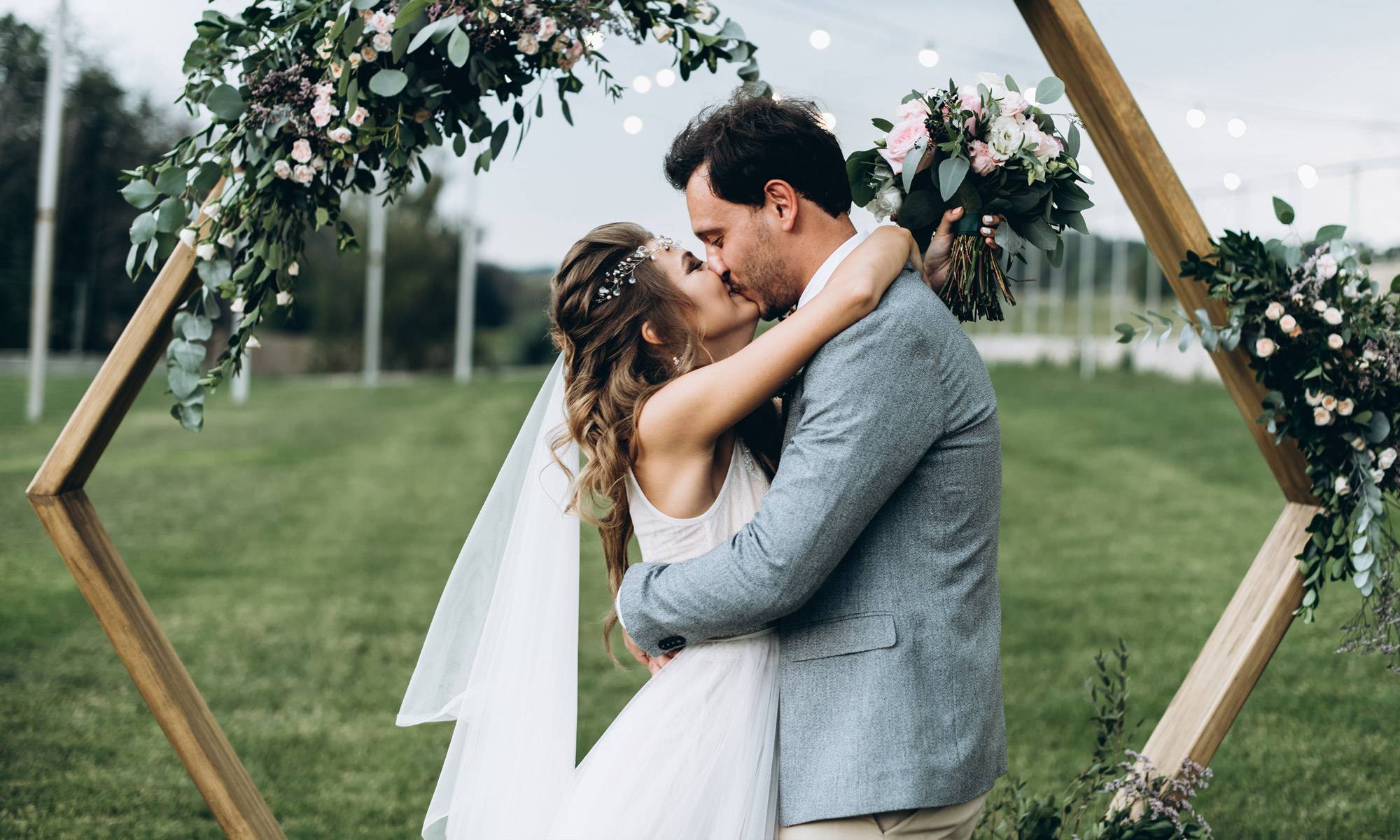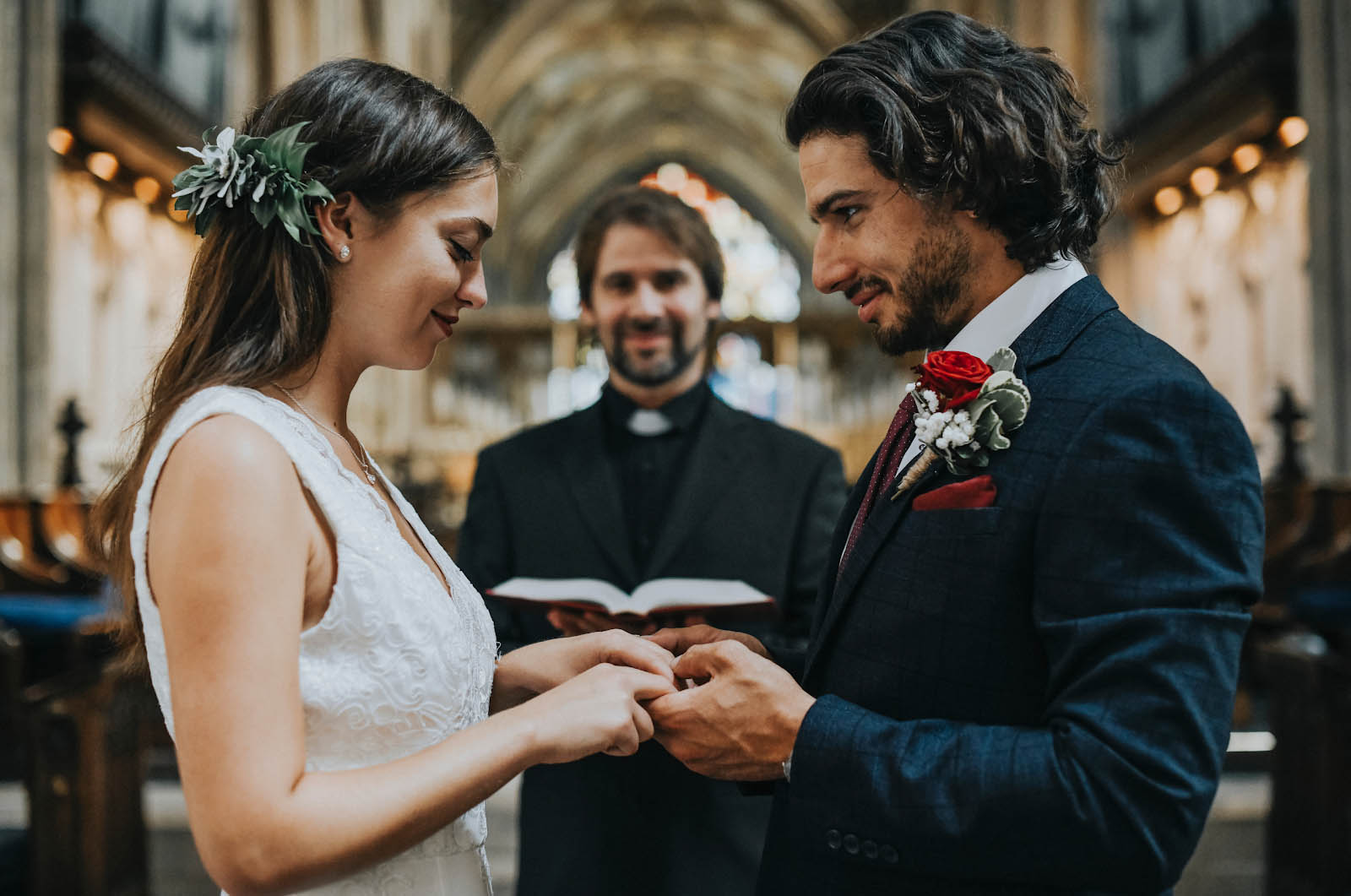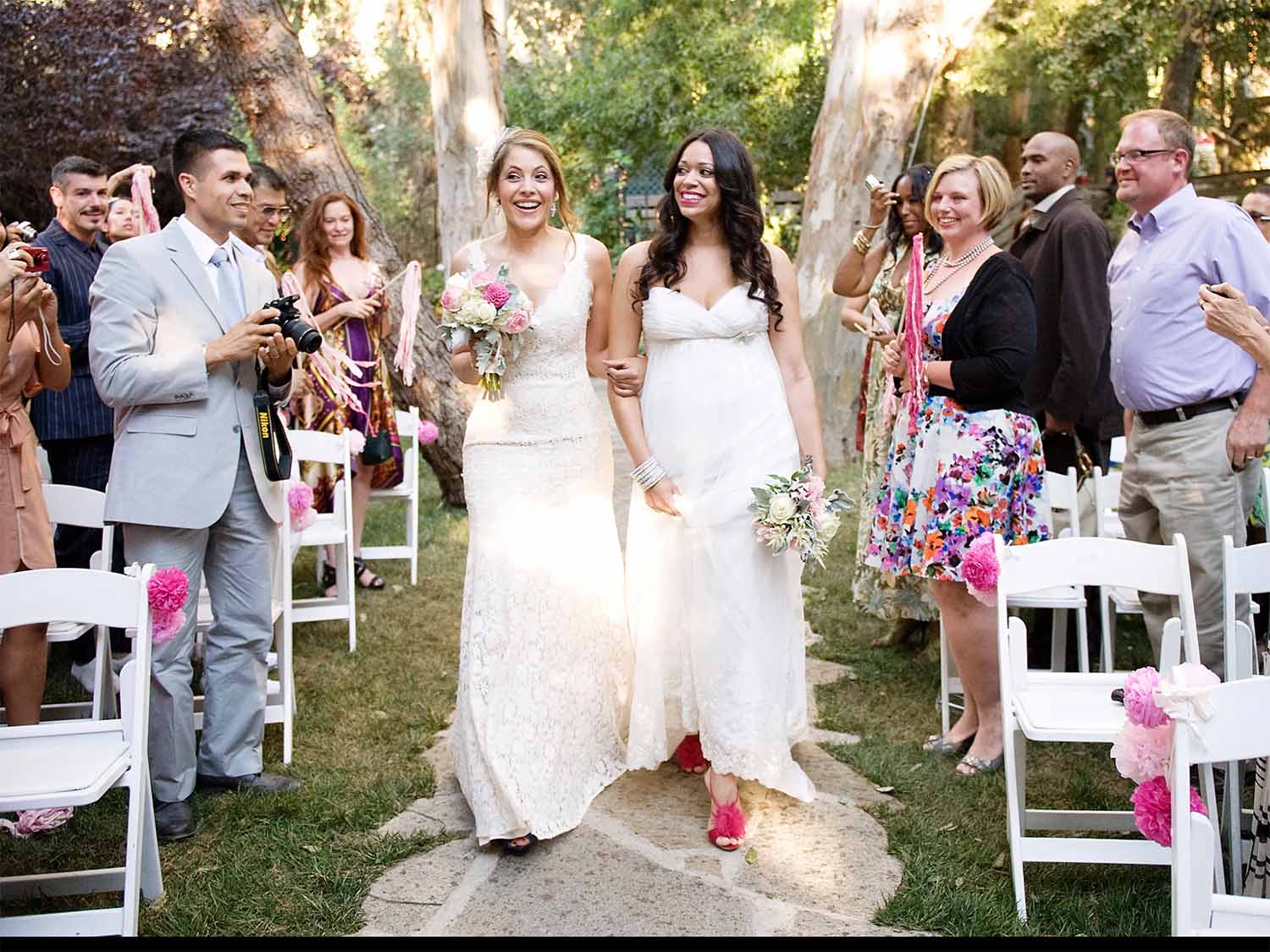2024 Wedding Ceremony Order 101: Outline & Timeline & Tips
Wedding Ceremony Order 2023 [Guide & Tips]

Every couple’s story is unique, and so is their big day-especially when it comes to the arrangement of wedding ceremony. Couples who want to wed legally typically require only a state-issued marriage license, an exchange of vows, a verbal agreement to enter a marriage contract and a proclamation that they are legally married. Beyond that, you have plenty of flexibility when it comes to how you invite loved ones to your wedding, how you exchange wedding vows, and whether you opt for a secular or religious wedding.
Can’t figure out where to go? Below, we have rounded up a variety of wedding ceremony outlines with advice from experts that you should use to set your own nuptials on a solid foundation for the order of events.
FAQ
In most wedding ceremony orders, regardless of the type of wedding, the prelude to the wedding ceremony involves the guests getting in and taking their seats first. After this follows the wedding procession of the bridal party before the wedding ceremony can begin.
In summary, after the processional and the welcome address by the officiant, the wedding ceremony can begin. It would usually involve a reading before the exchange of vows, the exchange of rings, and the declaration of the marriage when the couple is official. It ends with some closing words and a recession.
This is to say whether you’re having a Christian or a Civil wedding, choosing the order for the ceremony is really quite simple. And it depends on what the couple agrees on based on their beliefs for a wedding ceremony order of events. It’s more time to think the wedding order of service instead of wedding registry gift ideas.
In general, a typical wedding ceremony would need an officiant, and usually has specific rituals depending on the culture. For instance, reading a poem, honoring parents or a sand ceremony, and so on. Namely, the wedding list would have to include music which can add to the ambiance in the background.
Generally speaking, a mixed wedding or international wedding can be the most interesting. In other words, it is possible to pick rituals from the different mix of cultures for this. As long as there is an officiant, a procession and recession and vows are exchanged in the presence of witnesses. After all, the wedding ceremony order can flow whichever way the couple chooses.
What Is Typical Wedding Ceremony Order?

In general, certain people have to be recognized in a proper order in preparing for a wedding ceremony. At a typical wedding ceremony, other participants typically include bridesmaids, maids of honor, best man, groomsmen, flower girls, ring bearer, and parents of the couple.
Similarly to wedding schedule templates, the following are the steps involved in a typical wedding ceremony order of service.
- Procession: The entrance music plays as soon as the bride is ready and the guests stand to their feet to usher her in.
- Bridal Entrance: Usually, the flower girl and ring bearer lead the way, and the maid of honor and bridesmaids follow. And the bride enters last, on the arm of her father or male representative.
- Welcome/Introduction: At this point, the minister or officiant say a few words about the couple and gives a speech on marriage. Afterward, he would ask the congregation if any objects to the wedding and wait for a response or none.
- Vows Exchange: The couple each makes their promises to one another, usually repeating after the minster.
- Exchange of Rings: Also with the rings, the ring bearer gives the rings to the couple and they say more vows, each repeating after the minister and sliding the rings onto the finger of each other.
- Man and Wife: Here the minister makes a short speech pronouncing the couple husband and wife. At this point, the groom kisses the bride to the applause of their audience.
- Exit: At this point, the bride and groom sign the marriage register which answers the question, what is a marriage license. What follows is the recessional, their exit from the traditional wedding ceremony.
Guide Yourself Through Parts Of A Civil Wedding

Most people would probably think that a civil service may seem boring and impersonal, however, it does not have to be that way. Additionally, you can personalize parts of a wedding so you can make it your own. Even though there might not be much difference between ms and miss, but there can be between your wedding and others.
- Prelude (Optional): Light music perhaps while the guests settle down.
- Procession: Music announces the arrival of the bride and the guests stand.
- Bridal Entrance: Bridal party marches followed by the bride.
- Welcome/Introduction: Few words said by the officiant on the couple and marriage.
- Reading: (Optional)
- Music (Optional): There might be a soloist play a song or just light background music.
- Vows Exchange: The couple says their vows.
- Exchange of Rings: The couple exchange rings.
- Rose Ceremony (Optional): In some ceremonies, the couple can exchange roses and also give to their parents and family members.
- Man and Wife: The couple is pronounced man and wife by the officiant.
- Exit: The ceremony is complete and the couple and bridal party exit. They are now Mr. and Mrs. And the bride won’t have to learn how to change name.
Religious Wedding Order Of Events

The order of the wedding ceremony usually follows the religious rules of a religious wedding. Pentecostal, Coptic, Buddhist or Catholic, the religion will set the pace. However, there are some basic steps embraced by many.
- Prelude (Optional): Usually religious music plays while the guests take their seats.
- Procession: More themed music while the bridal train marches in.
- Bridal Entrance: The bride marches in on the arm of her loved one, usually her father.
- Welcome/Introduction: The minister says a few words to introduce the couple and the ceremony.
- Prayer (Optional): A prayer is said by the minister.
- The Declaration of Intention by Couple (Optional): The declare their intent to marry in a speech or they read it to the congregation…
- The Declaration of Support (Optional): The parents declare their support of the marriage.
- Music (Optional): More religious music is played.
- Reading (Optional): Scripture based on the topic of marriage is read from the religious text.
- Sermon/Address (Optional): The minister gives a sermon or speech on marriage and enduring love and faith.
- Musical (Optional): More religious music is played.
- Vows Exchange: The couple says their vows, make their promises to each other.
- Exchange of Rings: The couple says more vows and exchange rings.
- Lighting of the Unity Candle (Optional): The bride and a groom light a candle to signify their union.
- Blessings (Optional): The minister blesses the couple and everyone else attending the ceremony.
- Man and Wife: The couple is pronounced man and wife by the minister.
- Exit: The couple exit the ceremony followed by the bridal party.
Same-Sex Ceremony Order

There are differences between same-sex marriage ceremonies and heterosexual ones. In this order, both partners can walk down the aisle together, or one partner can walk in with the groom. Another option is for partners to walk in one after the other in the company of one or both of their parents.
- Word of welcome: The welcome address is usually first on the list in the wedding ceremony outline. At this point, the officiant says a few words in welcome of the guests, introduces the couple and the union everyone has gathered to witness.
- Reading: Whether you are using a traditional wedding ceremony outline or a Christian wedding ceremony outline, there are a number of options for the wedding ceremony reading. It can be prayers, reading of a religious passage, meaningful quotes or even favorite poems often read by assigned guests.
- The expression of intent: This point in the wedding ceremony layout is where the couple agrees to marry each other. Also known as the declaration of intent, it is where they say the “I do’s”.
- The affirmation of family and friends: In this part of the wedding procedure, the officiant will ask the guests present for their blessing of the union and communicate the response to the couple.
- The exchange of vows: After the readings and affirmations, at this point in the wedding ceremony schedule, the couple can exchange their wedding vows. This is their promise to each other. These can be the standard vows of a traditional wedding ceremony or vows they wrote themselves.
- The giving and receiving of rings: During the exchange of vows, couples place their wedding rings on each other’s fingers following the ceremony. As a symbol of their future together, this symbolizes a new beginning. The ring exchange is an important symbol of their union. A few more words might be said during the ring exchange.
- Affirmation of the marriage: The affirmation of the marriage in the wedding program order of service is the kiss. The officiant says words akin to, “I now pronounce you husband and husband, wife and wife, or husband and wife.” And then declares that you can seal the marriage with a kiss. This kiss is a way of officially declaring your union in the presence of your friends, family, everyone that you hold dear.
- Declaration of Marriage: At this point in the wedding service after the couple has sealed their marriage with a kiss, the officiant officially declares them married. In some instances, there might be closing prayers if it is a religious ceremony, or the officiant would say a few words of encouragement to the couple if it is a non-religious affair.
- Signing of the Marriage Register: This point in a typical wedding ceremony indicates the end or near end of the ceremony. The couple along with the registrar and their witnesses take turns in signing the marriage register.
- Introduction of the couple: As in a standard wedding ceremony, the couple is introduced officially to their guests as married. The wedding ceremony is complete, and their union a done deal.
Do I Need An Order Of Service?

A wedding ceremony format can also be used as an order of service, which can be seen in your wedding program outline. The order below outlines the steps that your wedding ceremony will take from start to finish and is essential for an easy ceremony flow. Here are the steps that can be followed during a traditional wedding ceremony order of service.
- Processional: The entrance of the wedding party after the guests have been seated.
- Welcome: A welcome address from the officiant.
- Readings: The readings of meaningful religious passages, sentimental quotes, or even prayers by assigned guests.
- Officiant’s Address: A few words by the officiant to the couple and guests at the marriage ceremony.
- Expression/Declaration of Intent: Where the couple says their “I dos.”
- Exchange of Vows: The couple read out their vows or promises to one another.
- Exchange of Rings: The traditional exchange of rings, an act that cuts across most types of weddings.
- Closing Remarks: The final words from the wedding officiant.
- Pronouncement: The official declaration of marriage by the officiant.
- Recessional: The couple exit followed by the bridal party.
The wedding ceremony is one of the most important parts of your wedding day, and it’s important to have a plan. We’ve outlined a timeline for you below so that you can stay organized and on track for the most perfect day ever! If this sounds like something that would be helpful for other brides who are getting married soon, please share our blog post with them by clicking one of the social media buttons below.
Comments are closed.